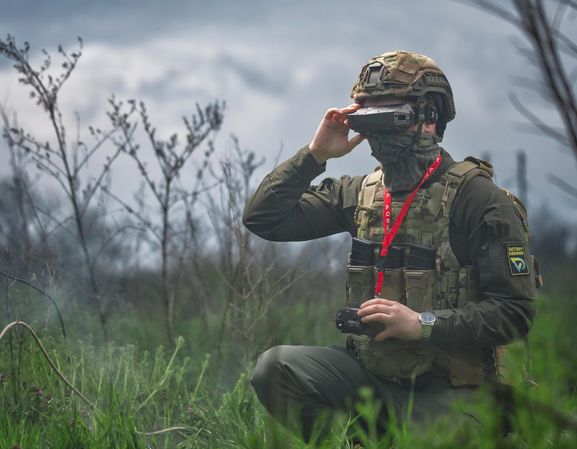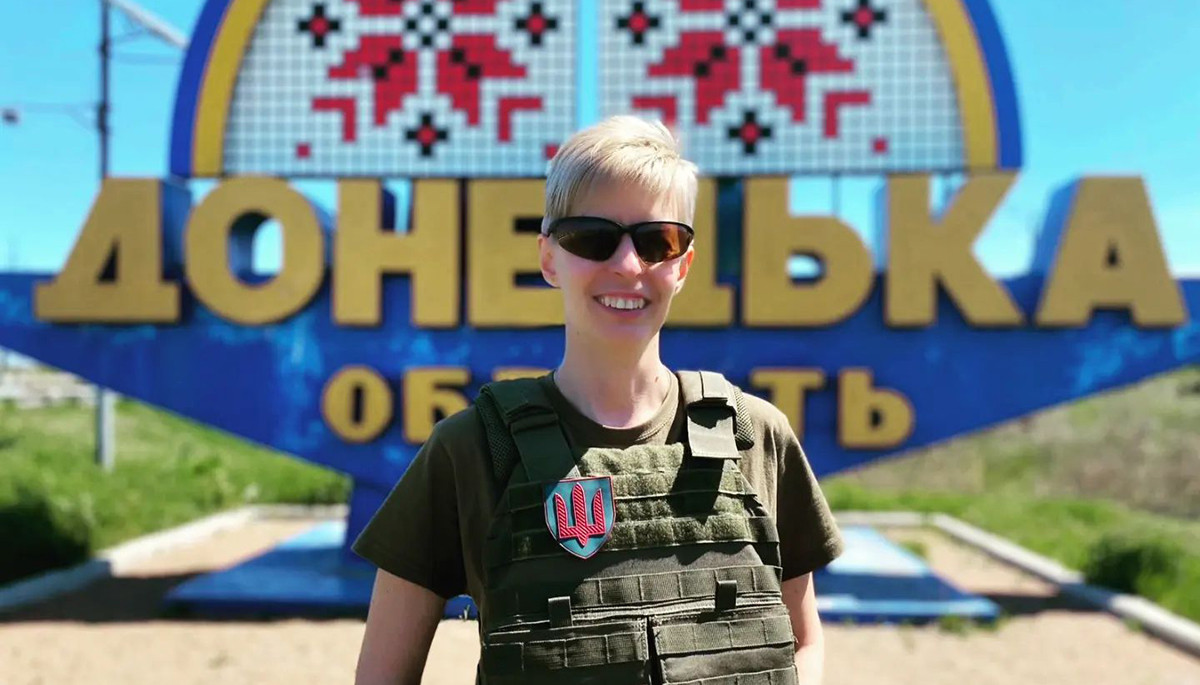How two women revolutionized drone training in Ukraine
Ukraine can only win if it has a technological edge, Maria Berlinska realized in 2015. Now, the Dignitas Fund she co-founded trains thousands in drone warfare, making flying robots, not foot soldiers, the new face of combat.


Combat drone operation has become a crucial skill in Ukraine, relevant for both military personnel and civilians. While the state-run Army of Drones program provides drones and organizes operators, private initiatives like the Victory Drones program by the Dignitas Fund have made significant contributions, in particular in operators’ training.
Founded by Maria Berlinska, a Ukrainian veteran aerial reconnaissance specialist, and Liuba Shypovych, a Ukrainian-born US IT company owner, the Dignitas Fund aims to help Ukrainians master drone technology. Their impact has been substantial, with the Victory Drones program training 92,000 service members by the first half of 2024.
Recognizing the importance of this new warfare tactic, the Ukrainian military has pioneered the integration of specialized strike drone companies into each brigade and large unit, totaling 67 such companies by early 2024. This shift was formalized in February 2024 when President Volodymyr Zelenskyy established Unmanned Systems Forces as a distinct branch of the Armed Forces.
Euromaidan Press explains why Dignitas seeks specifically women as drone pilots, how Ukrainian drone pilots keep an edge over Russians despite being outnumbered, how they resist Russian attempts to infiltrate the program, and what is Ukraine’s only chance to win against the numerically superior Russia.
What it takes to develop skilled drone pilots
The Dignitas training program offers a comprehensive approach to drone operation, beginning with an open-ended online theoretical course on Prometheus, Ukraine’s largest online learning platform. Access is tightly controlled, requiring official commander approval for specific email addresses.
“It’s a closed course to make it more difficult for Russians to access, though they still try to learn from us,” explains Liuba Shypovych, co-founder of Dignitas. Despite these precautions, there have been instances of Russian attempts to infiltrate the program, highlighting the value of the training.
Following the online portion, soldiers undergo four-day initial practical training at a shooting range, where they can apply their skills. Shypovych outlines the essential competencies: “Setting up Starlink, connecting power sources, operating drone software, launching drones, transmitting coordinates, and analyzing radio frequencies.”
The program then advances to a 33-day FPV (First Person View) training course at an Armed Forces of Ukraine training center, covering piloting and engineering. Specialized training for specific units with more specialized drone models is also available upon request.
“FPV piloting requires continuous practice, similar to flying planes,” Shypovych explains. With drones reaching speeds up to 200 km/h and being extremely sensitive to hand movements, operators maintain their skills through regular simulator practice, even during off-hours.
Maria Berlinska, the other co-founder, emphasizes the human factor:
“Our most important strength is not HIMARS or F-16, but people.”
She notes that while Russia has adopted FPV drone strikes, the superior quality and preparation of Ukrainian pilots maintained their advantage in early 2024, even when outnumbered in certain areas.

Empowering women, veterans, and youth
Dignitas, in collaboration with state initiatives like Victory Drones, has launched several niche but crucial programs. One notable example is a partnership with a major Ukrainian retail chain to support women’s training in aerial reconnaissance.
“While the training content is identical for all, we specifically target women applicants,” explains Shypovych. “The funds raised allow us to provide both training and drones to women participants, whereas men receive only training.”
This positive discrimination addresses a demographic shift in Ukraine’s military. Due to the mass mobilization of men, the percentage of women in the armed forces has decreased from up to 12% in some branches to just 4% across the entire security and defense sector, even though the total number of women serving in the army has increased.
Another initiative, called “Fly,” focuses on teaching piloting and engineering skills to former military personnel with amputations. While they may not become frontline operators, they can serve as motivated and inspiring instructors. “No one will sit there and say, ‘Oh, I can’t do it’ if they see an instructor with one arm succeeding,” Shypovych explains.
“Mom, is it a nuclear bomb?” Ukrainian MP Sovsun on parenting, parliament, and perseverance in Kyiv
Dignitas has also worked with Ukrainian MP Inna Sovsun to introduce drone technology into the high school curriculum for the Defense of Ukraine subject.
“It’s not just about drone assembly,” Shypovych emphasizes. “It’s about the entire ecosystem – drones, radios, Starlinks, tablets, and software. A drone alone means nothing; it’s important within this broader context.”

After fighting Russians in eastern Ukraine from 2014 to 2015, Maria Berlinska concluded that Ukraine’s only path to victory against the numerically superior Russia is through technological superiority.
“The technological militarization of society is the only way to preserve lives and statehood,” Berlinska asserts, emphasizing that drones can perform many tasks in place of soldiers, thus saving lives.
Ukraine’s evolving drone strategy
As the Dignitas Fund continues to refine its training programs, Ukraine’s overall drone strategy has evolved in tandem. The country’s approach goes beyond just creating skilled operators; it encompasses a full ecosystem of drone development and deployment.
In 2022, Ukrainians began producing them domestically. This grassroots movement led to the state-launched Army of Drones program. In 2023, over 300,000 drones were provided to the Ukrainian army, with a goal of one million in 2024, according to Digital Transformations Minister Mykhailo Fedorov. 90% of these drones were made in Ukraine by domestic companies, though mostly using foreign, predominantly Chinese parts. As time passed, the share of Ukrainian parts also gradually increased.
Airfield assassin: Ukraine’s Palianytsia drone threatens Russian rear
The Dignitas fund’s Narodnyi FPV (People’s FPV) project offers free courses for Ukrainians to build FPV drones from scratch using open market parts. These drones are then tested by specialists and sent to the frontline. As of June 2024, it has trained 11,000 Ukrainians and provided 2,500 drones to the army.
Ukrainian engineers are now testing AI-equipped drones capable of detecting targets and striking without human intervention, aiming to reduce dependence on operator control and vulnerability to Russian electronic warfare.
They’ve also developed long-range reconnaissance drones like the Leleka-100, Valkyria, and Shark. They’ve continued developing longer-range strike drones, capable of reaching targets deep inside Russia, as seen in the 2024 campaign against oil refineries and military airfields nearly 2,000 kilometers away. In August 2024, Ukraine unveiled its first drone-missile, Palianytsa, featuring a jet engine for increased speed.

A company commander, Oleksandr Yabchanka, at the Da Vinci Wolves battalion, reported the early adoption of robotic turrets called ShaBlia (Sabre) in 2023. This bulletproof automated system for machine guns, combined with drones, allows remote firing. Operators can control the turret via cable from a dugout 100 meters away, enhancing safety while maintaining combat effectiveness.
“The enemy intensely shells the turret’s position, thinking you’re there – but you’re safely underground, monitoring via camera,” Yabchanka told Euromaidan Press. “While it doesn’t eliminate all danger, our goal is to make Russian losses disproportionately larger than ours.”
Ukraine’s wake-up call to the West
Maria Berlinska warns that the West, despite interest in Ukrainian military technologies, underestimates the danger to itself.
She poses a provocative scenario: “Imagine thousands of Russian attack drones flying into Brussels. What happens next?”
Berlinska emphasizes the threat posed by the “axis of evil” – Russia, China, Iran, North Korea, and Belarus. Countries closer to Ukraine grasp this danger more acutely, while those further away, particularly NATO members, feel a false sense of security. She questions NATO’s readiness for modern drone warfare, arguing that preparation lags far behind the threat level.
Ukraine’s effective response to Russian aggression through technological innovation and societal mobilization serves as a model. However, Berlinska stresses, more resources are needed.
“Ukraine is investing tens of thousands of lives in global security. All the West needs to do is provide weapons – a cheap price to pay,” she says.
Drawing parallels, Shypovych recalls how many Ukrainians in 2021 thought the war was confined to Donbas, only to see it reach Kyiv and Lviv.
“Russian missiles can reach all of Poland and France. Europe must learn from Ukraine’s lesson and engage before the war spreads,” she warns.
Both Berlinska and Shypovych understand this conflict as more than just Russia-Ukraine war – it’s a clash between the civilized world and imperial ambitions, between autocracies and freedom. They caution against complacency, noting that the Russian expansionist wars didn’t stop with Georgia or Chechnya but moved further to Ukraine after a weak western response.
Criticizing the West’s outdated security approach, they highlight potential vulnerabilities in European defense capabilities. The war, they argue, extends beyond the frontline through economic, informational, and cyber warfare.
“Ukrainian soldiers are buying time, not only for their families but for the entire Western civilized world – at the cost of their lives and health,” Berlinska concludes poignantly.
***
Following our interview, Ukraine’s capabilities were dramatically demonstrated through a surprise incursion into Russia’s Kursk Oblast, capturing over 1,000 km² in days. Throughout summer 2024, Ukraine continued long-range strikes against Russian rear targets, using domestically produced drones. These actions, targeting oil refineries, fuel depots, and airfields, validated Berlinska’s assertion that preemptive strikes are more cost-effective than dealing with the aftermath of attacks.
“We need to destroy that tank before it can inflict harm,” Berlinska emphasizes, advocating for neutralizing military targets on Russian soil. This strategy aligns with Ukraine’s ongoing requests to Western partners to lift restrictions on using long-range weapons within Russian territory.
Berlinska’s frustration is palpable as she discusses the time needed for Western decision-making.
“Steel is the cheapest price the Western world can pay,” she warns, cautioning that delays in weapons deliveries have cost tens of thousands of Ukrainian lives.
Related:
- “Mom, is it a nuclear bomb?” Ukrainian MP Sovsun on parenting, parliament, and perseverance in Kyiv
- Airfield assassin: Ukraine’s Palianytsia drone threatens Russian rear
- 500km game-changer: Ukraine’s ballistic missile breakthrough can alter war dynamics



